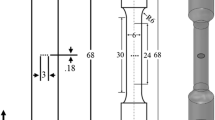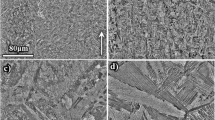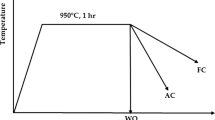Abstract
Background
This study investigates the effects of pores on the mechanical properties of metals produced by additive manufacturing, which can limit strength and ductility.
Objective
This research aims to both measure and model the rate of crack growth emanating from these pores in additively manufactured Ti-6Al-4 V fabricated with laser powder bed fusion.
Methods
Uniaxial tensile samples containing intentionally embedded penny-shaped pores were mechanically tested to failure, and loading was interrupted by a series of unload steps to measure the stiffness degradation with load. The factors contributing to reduction in stiffness, namely (1) elastic and plastic changes to geometry, (2) the effect of plastic deformation on modulus, and (3) crack growth, were deconvoluted through finite element modeling, and the crack size was estimated at each unloading step.
Results
The stiffness-based method was able to detect stable crack growth in samples with large pores (1.6% to 11% of the cross-sectional area). Crack growth as a function of strain was fit to a model where the crack driving force was based on equivalent strain and a model where the crack driving force was based on energy release rate.
Conclusions
Significant crack growth occurred only after the onset of necking in samples containing small pores, while samples containing large pores experienced continuous crack growth with strain.
Graphical Abstract












Similar content being viewed by others
Data Availability
All relevant data are available from the authors.
References
Gibson I, Rosen D, Stucker B, Khorasani M (2021) Additive manufacturing technologies, 3rd edn. Springer. https://doi.org/10.1007/978-3-030-56127-7
Seifi M, Gorelik M, Waller J et al (2017) Progress towards metal additive manufacturing standardization to support qualification and certification. JOM 69:439–455. https://doi.org/10.1007/s11837-017-2265-2
Nguyen HD, Pramanik A, Basak AK et al (2022) A critical review on additive manufacturing of Ti-6Al-4V alloy: Microstructure and mechanical properties. J Market Res 18:4641–4661. https://doi.org/10.1016/j.jmrt.2022.04.055
Gong H, Rafi K, Gu H et al (2014) Analysis of defect generation in Ti-6Al-4V parts made using powder bed fusion additive manufacturing processes. Addit Manuf 1:87–98. https://doi.org/10.1016/j.addma.2014.08.002
Kasperovich G, Haubrich J, Gussone J, Requena G (2016) Correlation between porosity and processing parameters in TiAl6V4 produced by selective laser melting. Mater Des 105:160–170. https://doi.org/10.1016/j.matdes.2016.05.070
Furton ET, Wilson-Heid AE, Beese AM (2021) Effect of stress triaxiality and penny-shaped pores on tensile properties of laser powder bed fusion Ti-6Al-4V. Addit Manuf 48:102414. https://doi.org/10.1016/j.addma.2021.102414
Wilson-Heid AE, Novak TC, Beese AM (2019) Characterization of the effects of internal pores on tensile properties of additively manufactured austenitic stainless steel 316L. Exp Mech 59:793–804. https://doi.org/10.1007/s11340-018-00465-0
Wilson-Heid AE, Furton ET, Beese AM (2021) Contrasting the role of pores on the stress state dependent fracture behavior of additively manufactured low and high ductility metals. Materials 14:1–15. https://doi.org/10.3390/ma14133657
Chen S, Osovski S (2020) Damage evolution around an embedded pore in quasi-static shear dominant compression and tension specimens. Mech Mater 148:103513. https://doi.org/10.1016/j.mechmat.2020.103513
Fadida R, Shirizly A, Rittel D (2020) Static and dynamic shear-compression response of additively manufactured Ti6Al4V specimens with embedded voids. Mech Mater 147:103413. https://doi.org/10.1016/j.mechmat.2020.103413
Meng LX, Ben DD, Yang HJ et al (2021) Effects of embedded spherical pore on the tensile properties of a selective laser melted Ti6Al4V alloy. Mater Sci Eng, A 815:141254. https://doi.org/10.1016/j.msea.2021.141254
Chobin M (1990) A consideration on stable growth of a ductile crack in a center cracked plate of 70/30 brass. Eng Fract Mech 37:263–273. https://doi.org/10.1016/0013-7944(90)90039-J
Rice JR (1964) A path independent integral and the approximate analysis of strain concentration by notches and cracks. Journal of Applied Mechanics, Transactions ASME 35:379–388. https://doi.org/10.1115/1.3601206
Rice JR, Drugan WJ, Sham TL (1980) Elastic-plastic analysis of growing cracks. ASTM Special Technical Publication 189–221. https://doi.org/10.1520/stp36972s
Lemaitre J, Dufailly J (1987) Damage measurements. Eng Fract Mech 28:643–661. https://doi.org/10.1016/0013-7944(87)90059-2
Sancho A, Cox MJ, Cartwright T et al (2016) Experimental techniques for ductile damage characterisation. Procedia Struct Integr 2:966–973. https://doi.org/10.1016/j.prostr.2016.06.124
Sheridan L, Gockel JE, Scott-Emuakpor OE (2020) Rapid initiation and growth life characterization of additively manufactured alloy 718 through compliance monitoring. Extreme Mech Lett 40:100856. https://doi.org/10.1016/j.eml.2020.100856
Song Y, Magmanlac DJ, Tagarielli VL (2022) A new stiffness-sensing test to measure damage evolution in solids. Sci Rep 12:1–14. https://doi.org/10.1038/s41598-021-04452-9
Bonora N, Ruggiero A, Gentile D, de Meo S (2011) Practical applicability and limitations of the elastic modulus degradation technique for damage measurements in ductile metals. Strain 47:241–254. https://doi.org/10.1111/j.1475-1305.2009.00678.x
Yoshida F, Uemori T, Fujiwara K (2002) Elastic-plastic behavior of steel sheets under in-plane cyclic tension-compression at large strain. Int J Plast 18:633–659. https://doi.org/10.1016/S0749-6419(01)00049-3
ASTM E8/E8M Standard (2010) ASTM E8/E8M standard test methods for tension testing of metallic materials 1. Annual Book of ASTM Standards 4:1–27. https://doi.org/10.1520/E0008
3D Systems (2018) 15-D92 ProX DMP 320 LaserForm Ti Gr23 (A) Best practices
Han F, Tang B, Kou H et al (2016) Cyclic softening behavior of Ti–6Al–4V alloy at macro and micro-scale. Mater Lett 185:115–118. https://doi.org/10.1016/j.matlet.2016.08.119
Lems W (1962) The change of Young’s modulus of copper and silver after deformation at low temperature and its recovery. Physica 28:445–452. https://doi.org/10.1016/0031-8914(62)90022-8
Hayter A (2012) Probability and Statistics for Engineers and Scientists, 4th edn. Books/Cole, Cengage Learning, Boston, MA
Garrison WM, Moody NR (1987) Ductile fracture. J Phys Chem Solids 48:1035–1074. https://doi.org/10.1016/0022-3697(87)90118-1
Wierzbicki T, Bao Y, Lee YW, Bai Y (2005) Calibration and evaluation of seven fracture models. Int J Mech Sci 47:719–743. https://doi.org/10.1016/j.ijmecsci.2005.03.003
He MY, Hutchinson JW (1983) Penny-shaped crack in a round bar of power-law hardening material. ASTM Special Technical Publication 291–305
O’Dowd NP, Shih CF (1994) Two parameter fracture mechanics: theory and applications, vol 1207. ASTM-STP, American Society for Testing and Materials, Philadelphia, PA, pp 21–47
Narra SP, Rollett AD, Ngo A et al (2023) Process qualification of laser powder bed fusion based on processing-defect structure-fatigue properties in Ti-6Al-4V. J Mater Process Technol 311. https://doi.org/10.1016/j.jmatprotec.2022.117775
Acknowledgements
The financial support provided by the National Science Foundation through award number CMMI-1652575 and the National Science Foundation Graduate Research Fellowship under Grant No. DGE1255832 is gratefully acknowledged.
Author information
Authors and Affiliations
Corresponding author
Ethics declarations
Conflict of Interest
The authors declare that they have no conflict of interest.
Additional information
Publisher's Note
Springer Nature remains neutral with regard to jurisdictional claims in published maps and institutional affiliations.
E.T. Furton is a member of SEM.
Supplementary Information
Below is the link to the electronic supplementary material.
Rights and permissions
Springer Nature or its licensor (e.g. a society or other partner) holds exclusive rights to this article under a publishing agreement with the author(s) or other rightsholder(s); author self-archiving of the accepted manuscript version of this article is solely governed by the terms of such publishing agreement and applicable law.
About this article
Cite this article
Furton, E., Beese, A.M. Crack Growth of Defects in Ti-6Al-4V Under Uniaxial Tension: Measurements and Modeling. Exp Mech 64, 153–165 (2024). https://doi.org/10.1007/s11340-023-01008-y
Received:
Accepted:
Published:
Issue Date:
DOI: https://doi.org/10.1007/s11340-023-01008-y




